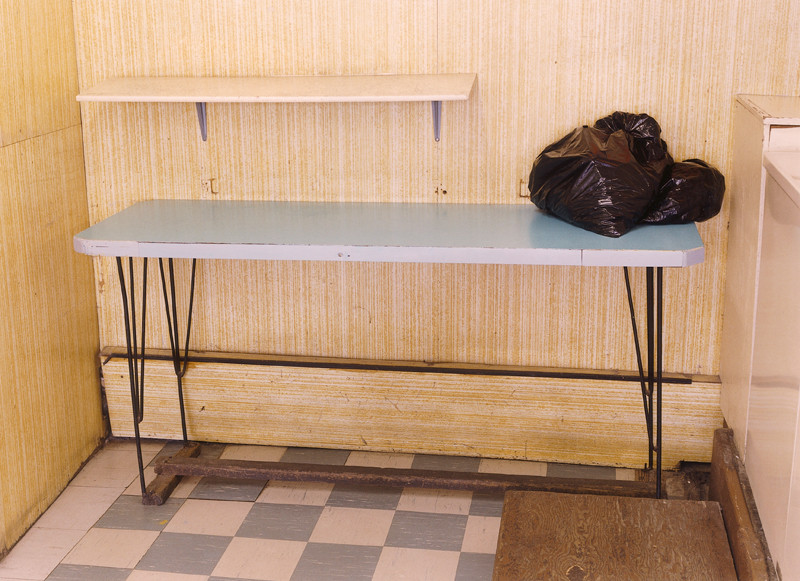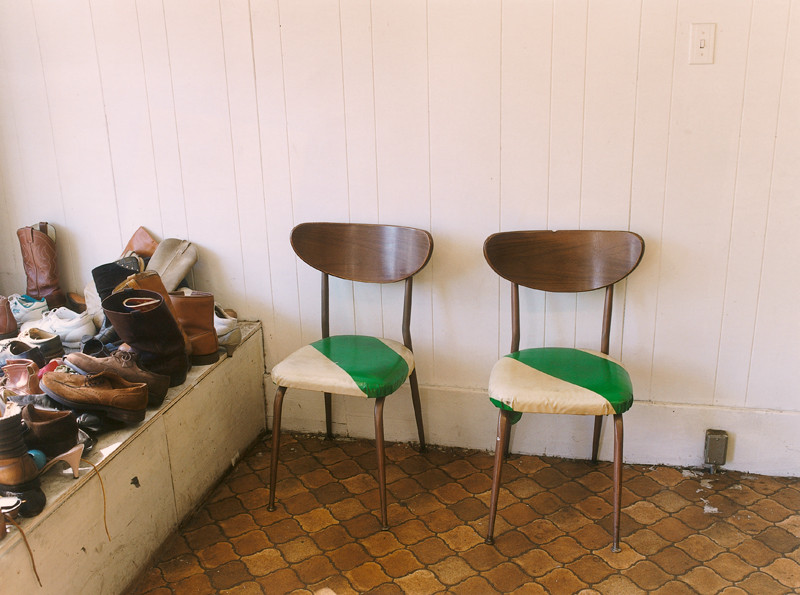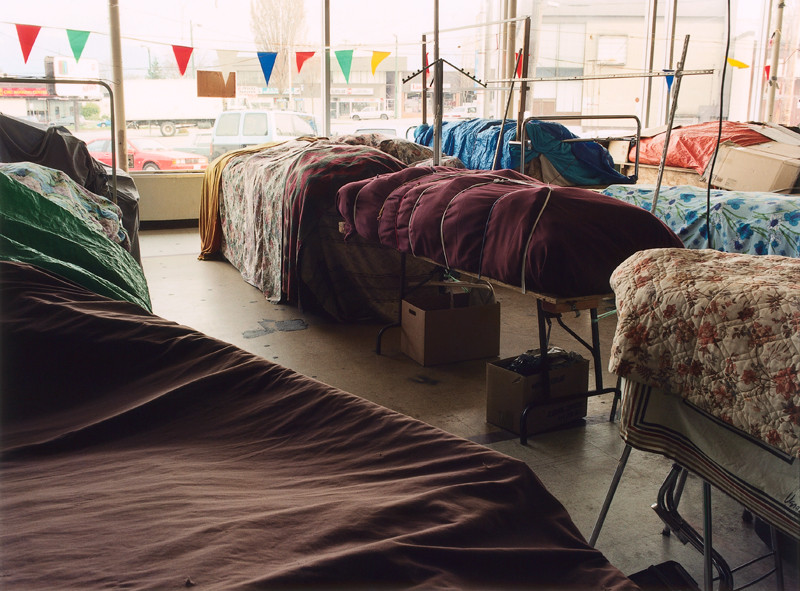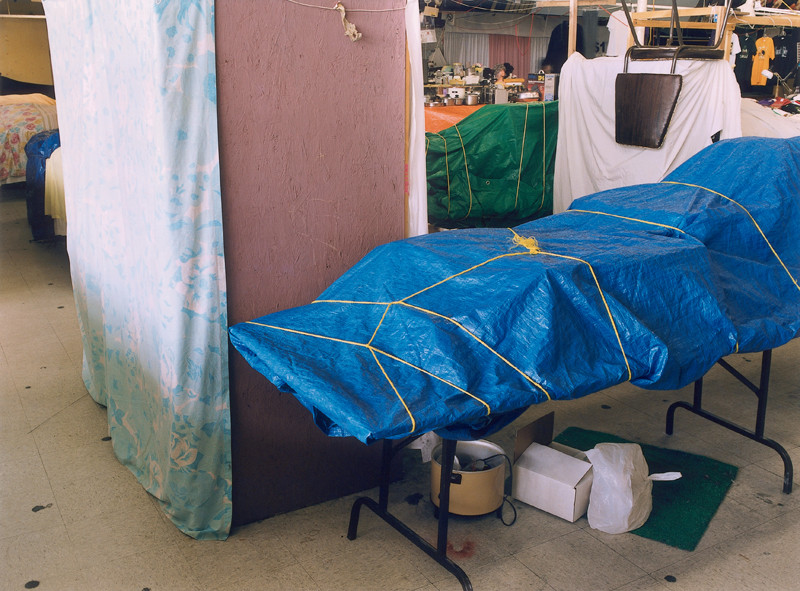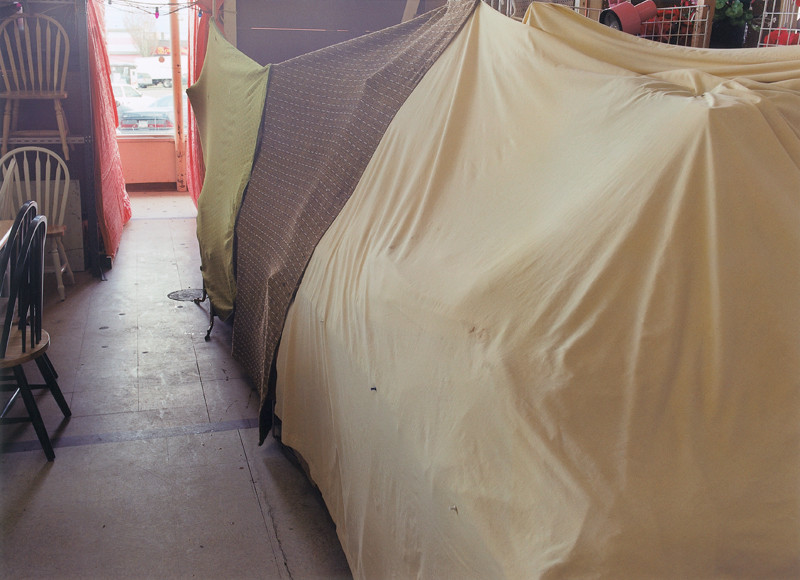[Fall 2000]
by Howard Ursuliak
For the past fifteen years, I have been interested in the material agency of both documentary photography and the visual display aesthetics of public advertising, and in how these two forms come together in configurations of urban space to mediate a dialectic of appearances between public and private realms of experience.
In this selection presented from the Store and Market series, I have been working through a realist vision that mimics photojournalism to depict the interiors of small, marginal commercial business spaces and deserted areas of a large flea market in the Vancouver area.
With the Store series, I was interested in the particularities of the shopkeepers’ agency; the decisions and labour that went into arranging the interior surfaces (goods and services), making them visible for a public. Evidence of this is apparent in the mixed accumulations of functional design and traces of a shopkeeper’s handicraft. The particular sensibility of visual display in each of these commercial interiors is defined by specular relations that are organized by the social conditions of exchange based on an older model of free-market enterprise. Traditionally, these conditions also established an intersubjective space for a local community and thus maintain a relevant sense of the public sphere. In contrast, one obvious condition of the display aesthetic of corporate capitalist consumption is its ability to project its surface allure everywhere as a more totalized image-space embodying a generic urban experience, thus investing in a more complex claim on the psychic life of its anticipated and imaginary social body. In the desolate Market images, on the contrary, there is a condition of not disclosing the “goods” to the gaze of a similar imaginary social body. Here, the relation of looking to seeing implies a form of social value and possession that is private and interiorized, and alludes more directly to an absence.
In an anthropological sense, these pictures present a history of the everyday as “the just past” of lived experience. There is a lived body of social memory lingering in the traces left upon the arrangement of material form. They bring to light a contemporary history of social relations and subjectivities that engage forms of symbolic and economic exchange. I find these spaces and the goods and services offered in them to be forlorn and cast off. Their exchange-value clings to a past that is fading from sight. How can they continue to be desirable in a changing economy that would have to anticipate their aura and sense of style as signs of value and social status affirming the need to belong in an image of the present? A mood of melancholic longing appears to pervade the pictorial space of these images, as if some lost material of historical time had displaced the present. As a lived memory of social forms, these images function like an archive of human presence.
Simultaneously, in these spaces, the sense of a social body is figured as an absence. I believe anticipation for its presence has given over to a desire for the “lived” memory, perhaps a form of historical continuity where the temporal conditions of desire could yield a sense of belonging and participation in the public sphere. This may sound both nostalgic and utopian, but I don’t believe that it is. It is a problem of alterity and the abject coming to terms with questions of the social value and meaning of aesthetic agency and practice, while being confronted by a dominant mode of productivity and its form of (art) historical time. I see the spaces of my images as a poetic locus for the intermingling of an imaginary social body and a desire to give regard to the pathos of alterity as an intersubjective relation that could yield a sense of shared moral ground (the necessity of community).
Much of my work has, in one way or another, examined the specular relation as a principle and condition of social presence. To a certain extent, this was a response to practices that reduced representation to a condition of visibility – that is, much work done around identity politics. It tended to produce personal narratives, or memories and histories, to account for its often retaliatory relationship with hegemonic structures and forms of history. In terms of appropriation, it made its claim for a self by taking on visible presence within the structure of a specular relation. As these practices should be all too familiar to us now, bounded as they are within a more general question of relativism, was there much that was very interesting brought forward in this examination of the relationship between the self and the other within the conditions of representation? One thing seems certain to me, which is that the value of social presence cannot be reduced to a condition of visibility. There would appear to be an ontological problem with this type of dialectic. The question must be asked whether it is possible for “being” to be a representation of itself. The question of value then, would be related to social being and the nature of its presence as required in the material organization of the specular relation. This condition of making visible for public display can only prefigure an anticipated and therefore imaginary social body. It is in the desire for presence, however, that becoming a social being takes on historical currency as a form of human agency. Formations of the value of social presence in this sense would be configured around the constructed and therefore imaginary boundaries between public and private space. These material relations can be understood as the corresponding social conditions attributable to the related terms of interiority and exteriority. The specular relation, inasmuch as it is the relation of looking to seeing, is about giving regard within the act of looking to something that cannot make an appearance.
To think about and practice a form of realism is a way of negotiating this relationship. In putting forward a model of experience, one is in a sense saying, Here, here is the world. It looks and feels like this. However, being in the world is not the same as occupying or being occupied by a subject position. Being in the world must necessarily involve forming a relationship with pure exteriority, which does not equate objectivity as an a priori condition. How does one make sense of being and experience in order to present a relevant image of the world?
The world as an image of existence (experience) does not present itself as a sign. Pictorial space does not offer a perceptual schema through linguistic signification, though signs can be read within the visual register. In order for pictorial space to seem real, it relies on the photographic image to provide its mimetic correspondence as an isomorphic relationship with actual space mediated through the camera’s lens. It is important to note how the technological function of the camera structures the relation of looking to seeing. Here, the concept of indexicality in relation to the trace figures prominently. But, ultimately, I think it is the desire for presence or continuity with presence that delivers the realist anticipation of truth in formations of social value.
Presence of what, though? This cannot be presence of the human as a sign of being, which would accompany a concept of trace. The human comes into being, but being cannot be a sign of its own presence. When considered within the dynamic of the specular relation, the sense of the trace is no longer that of a referent (an object relation), but a temporal sense with the potentiality to move toward and anticipate a configuration of the present. Continuity with presence is what is desired but never possessed. Presence remains as absence: outside of possession in relation to desire.
This text is revised and adapted from a previous version of the catalogue A Sadness without the Object, published by The Centre of Photography, University of Salamanca, Spain, in 1998.

